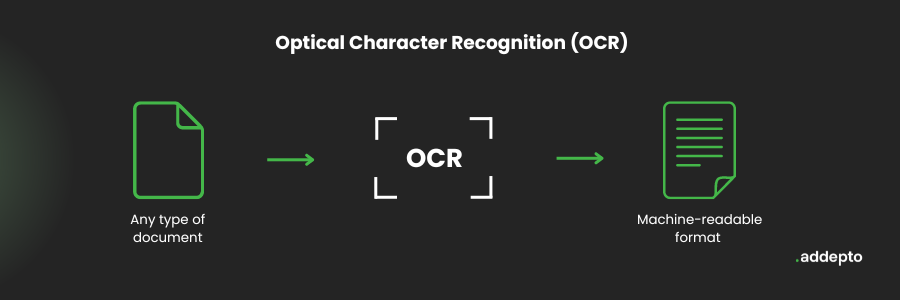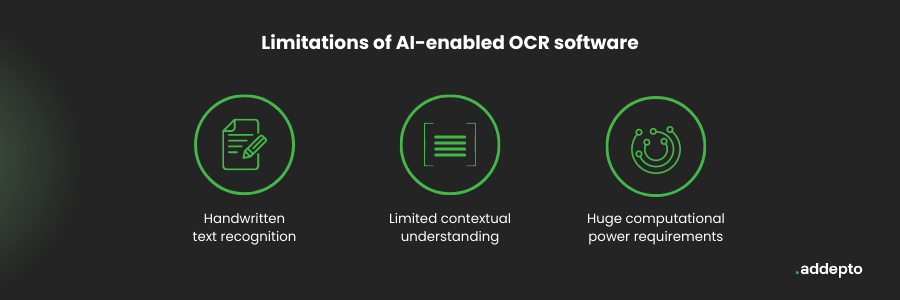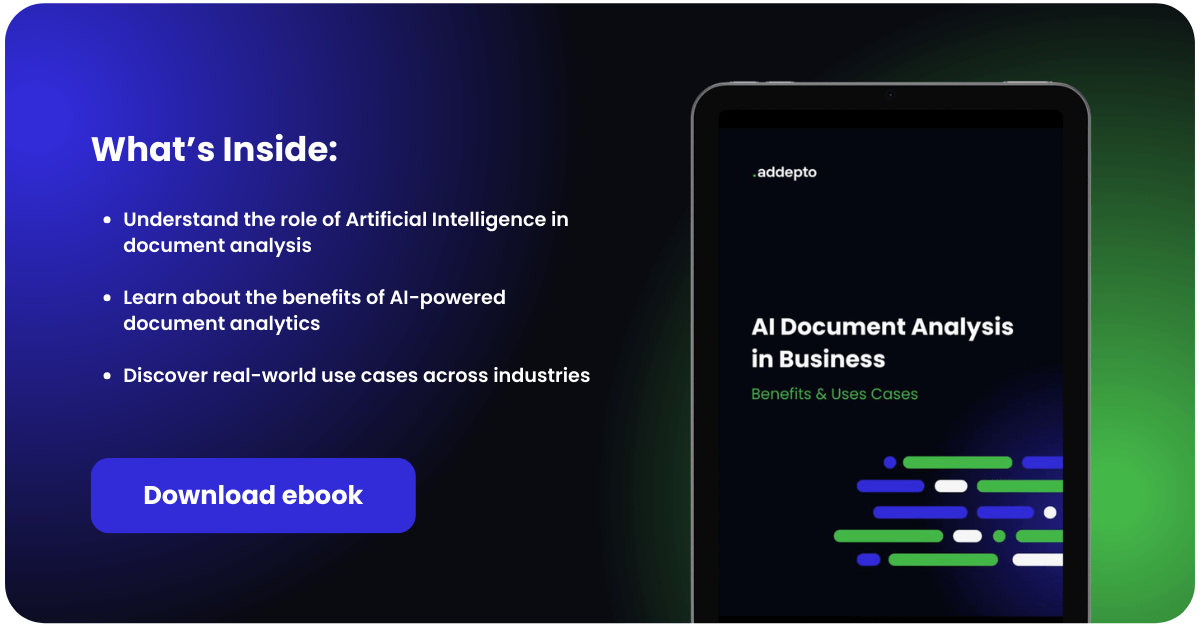
September 13, 2024
AI-Powered OCR (Optical Character Recognition): Enhancing Accuracy and Efficiency in Document Analysis
Author:

CSO & Co-Founder
Reading time:
12 minutes
Since the early 90s, Optical Character Recognition (OCR) has become a basic necessity for any organization dealing with a large volume of documents. But, with the ever-increasing need for business intelligence, and constant improvements in Artificial Intelligence, OCR has taken a new turn. OCR is no longer just used for scanning documents. When leveraged correctly, AI-powered OCR can revolutionize the analytics process by enabling businesses to extract unstructured data from documents for more streamlined and efficient analytics.
This article will evaluate how AI can boost OCR technologies and present more useful information, including how it works, the benefits it presents, and the current limitations of AI-enabled OCR software.
What is AI-powered OCR?
AI-powered OCR is a software solution that allows businesses to automatically extract and process information from various types of documents, including invoices, receipts, reports, and much more. [1]
The software processes images of text and converts them into machine-readable forms that can be analyzed using machine learning and deep learning technologies. [2]

When utilized correctly, AI-powered OCR can offer huge time-saving benefits, reduce costs, and reduce errors typically encountered through human error in manual data entry.

Read more about How AI is revolutionizing document analysis

How does AI-powered OCR software work?
AI-powered OCR software works much like regular OCR machines but with a few key differences. Unlike traditional OCR machines, which use rule-based algorithms to recognize characters in images and documents, AI-powered OCR software employs computer vision and machine learning technologies to identify the characters in images and documents, making it more accurate than traditional OCR.
Some software also comes with embedded NLP software to facilitate easier document analysis. The process typically follows the following basic steps:

Unlock the potential of AI-driven document analysis with our AI Text Analysis Tool. Get in touch with us to discover more.
Image acquisition
Through the scanner, the OCR software reads the document and converts the text into binary data. It does this by using computer vision technology to identify areas within the document that may contain text. This may involve analyzing various visual elements of the documents, such as color, shapes, and texture.
Preprocessing
At this stage, the software processes the image or document to optimize its quality and readability. This typically involves various tasks such as noise reduction, image rotation, deskewing, and contrast adjustment. By employing these processes, the software ensures that the image is clear and well-defined, thus streamlining the subsequent steps.
Text segmentation
Text segmentation typically involves separating individual characters or words to facilitate further recognition.
Feature extraction
The software then extracts relevant features from the segmented text. These features typically include different characteristics of the text, including shape, statistical properties, and texture.
Character recognition
The extracted features are analyzed using machine learning algorithms trained on large datasets of labeled data, enabling them to learn the patterns and relationships between the document’s features and corresponding words or characters. This enables the software to assign labels to the segmented text regions and recognize the textual content within images.
Post-processing
The primary purpose of post-processing is to ensure higher accuracy and enhance the overall quality of the recognized text. This includes various tasks such as context-based verification, spell-checking, and error correction.
After pre-processing, the OCR software then converts the recognized text into a digital format that can be further processed and analyzed.
How AI-powered OCR is transforming document processing and analysis
AI-powered OCR has the power to revolutionize document analysis. Here are some of the ways in which it enhances accuracy and efficiency in the process:

Improved accuracy and efficiency
Unlike traditional OCRs, which rely on rule-based algorithms to recognize text, AI-powered OCRs utilize advanced recognition algorithms. These algorithms include deep learning and machine learning algorithms, which are better equipped for advanced character recognition.
They achieve this by learning from the corpus of data in their training data sets, which enables them to adapt to various fonts, languages, and styles, resulting in more accurate and reliable data extraction.
AI-powered OCR software can also automatically detect errors and inconsistencies like spelling mistakes and missing data in documents. This eliminates the need for manual proofreading while improving the overall quality of data.
Language translation
Multinational organizations operating in different regions often have difficulty analyzing documents from different branches due to a language barrier. Traditionally, these organizations relied on human translators, but the emergence of digital translation systems changed that. With that said, having to process documents using multiple systems in different states can be quite laborious and time-consuming.
Fortunately, some OCR software comes with language translation capabilities that enable them to translate text in scanned documents into a preferred language automatically. And, unlike traditional translation systems, AI-powered OCR software can also translate other subtleties of speech, including cultural nuance and idiomatic expressions, which are often lost in traditional methods. This provides a wholesome translation that enables more effective analysis.
Sentiment analysis
Customer feedback is integral to understanding the sentiments of customers towards specific products and services. It is what enables organizations to gauge the success of different projects. Unfortunately, most customer feedback in the form of physical documents is mainly analyzed by human employees, who might not get the full picture.
Businesses can benefit from OCR software incorporated with deep learning technologies that enable them to analyze text data, extract important information, and categorize it into positive, negative, or neutral sentiments. [3]
With this information, businesses are better able to make data-driven decisions and gauge areas for improvement. It also helps identify customer needs, interests, and patterns.
Document summarization
Summarization is an integral part of document analysis. By summarizing key points, it is easier for human employees to skim through large volumes of data and make informed decisions. This process can be made even more straightforward with AI-powered OCR.
AI-powered OCR systems use natural language processing, machine learning, and deep learning technologies to provide text summaries during post-processing. [4] These tools can identify and remove redundancies in text data and offer personalized summaries.
Image recognition
Unlike traditional OCR systems, AI-powered OCR can detect not only text but also people and objects for easier visual processing. It can detect and identify objects and text in images, recognize faces, and categorize the captured data into various categories for easier analysis.

Discover more about Privacy Concerns in AI-Driven Document Analysis

Other benefits of AI-powered OCR software in the business
Intelligent automation
Intelligent automation is crucial for any business looking to gain a competitive advantage in a digital economy. However, many companies are unable to realize the benefits of business intelligence since most of their data is in the form of physical documents, which require a lot of time and energy to analyze.
Fortunately, with OCR, businesses can eliminate the long, tedious, and error-filled data entry tasks associated with analyzing documents manually.
AI-powered OCR takes this a step further by streamlining the processes in a more scalable and efficient way. This way, businesses can automatically extract and analyze text data from documents using a single system.
Improved data security
One of the greatest risks of handling physical documents is the risk of losing them, either by negligence or through accidents. And, once they’re gone, there is no way of getting them back. Paper documents also have a very short lifespan and take up a lot of storage space.
With OCR technology, businesses can easily transform their paper documents into digital formats that are much safer to store and handle. AI-powered software also comes with cloud storage options, which offer more security guarantees for sensitive documents.
Reduced costs
Besides making the process of information extraction from physical documents easier and faster, AI-powered OCR technology can offer significant cost-saving benefits in document analysis. Very often, the one-time or even subscription-based cost of procuring OCR hardware and software is much cheaper than hiring employees to process and analyze documents manually.
Improved efficiency
One of the most notable benefits of AI-powered technology in every aspect of the business is improved efficiency. With regard to document processing and analysis, AI-powered OCR technology can help analyze, organize, and process documents faster than any human could.
Eventually, this leads to more work being completed in a shorter duration of time, thus freeing up employees’ time to focus on other responsibilities.
Current limitations of AI-enabled OCR software
Despite the numerous benefits AI adds to OCR technology. There are still a few limitations that have to be overcome before businesses can realize the full potential of AI-powered OCR. Some of the most notable limitations include:

Handwritten text recognition
While AI-powered OCR technology can effortlessly recognize printed text in various fonts, it still faces significant challenges in recognizing handwritten text. This is because handwritten text varies greatly in style and clarity, making it difficult for the software to recognize it accurately.
Limited contextual understanding
Advancements in natural language processing and deep learning technologies have facilitated major strides in contextual understanding for AI systems. With that said, AI software still struggles with complex semantic analysis and understanding the full context of a document, especially for documents containing complex patterns of speech.
Huge computational power requirements
Most AI-powered optical character recognition technologies run on NLP, ML, and deep learning technology. These technologies often require high computing power, something that some small businesses may have trouble procuring due to the high cost of powerful computers.
Dependence on training data
The performance of AI OCR heavily relies on the quality and diversity of the training data. If the training datasets are biased or lack representation of various fonts, languages, or document types, the OCR system may perform poorly in real-world scenarios.
Handling of complex layouts
AI OCR can falter when dealing with documents that have complex layouts, such as tables without clear borders or multi-column formats. This limitation can lead to inaccuracies in data extraction, particularly in enterprise settings that require high precision.
Limited language and font support
While AI OCR has improved in recognizing different languages and fonts, it still has limitations. Some systems support only a limited number of languages, and specific stylized or handwritten fonts can pose challenges[2][3].
Black Box Nature
Many AI OCR systems operate as “black boxes,” meaning that when errors occur, it can be challenging to diagnose the problem or understand the decision-making process of the AI. This lack of transparency can complicate troubleshooting and improvement efforts.
Gen AI in OCR systems
Generative AI (GenAI) takes AI advancements in OCR systems further by addressing many limitations of traditional AI-OCR and offering more sophisticated capabilities.
The differences between AI-OCR systems and Generative AI (GenAI) OCR systems primarily revolve around their capabilities, flexibility, and the underlying technologies they employ. Here are the key distinctions:
Methodology
- AI-OCR Systems: These systems enhance traditional OCR by integrating machine learning and natural language processing. They improve accuracy and adaptability compared to traditional OCR but still rely on predefined rules and templates for character recognition. AI-OCR can learn from data but may not fully understand context or semantics.
- GenAI OCR Systems: They leverage advanced generative models, such as transformers, to analyze and interpret text within images. They go beyond simple character recognition to understand context, relationships between words, and the overall structure of documents. This allows for better handling of unstructured and semi-structured data.
Adaptability
- AI-OCR can automatically correct some errors based on learned patterns but is limited in its adaptability to new formats or layouts. It often requires retraining with new data to improve performance.
- GenAI OCR employs advanced algorithms that continuously learn and adapt, allowing it to correct errors more intelligently and recognize new patterns without extensive retraining. This makes it more versatile in dynamic environments.
Efficiency
- AI-OCR are generally faster than traditional OCR, but may still face bottlenecks when processing large volumes of diverse documents due to its reliance on predefined rules.
- GenAI OCR designed for high efficiency and speed, capable of processing complex documents quickly. Its ability to understand context allows it to streamline workflows significantly.
Final thoughts
OCR has come a long way, from the traditional rule-based systems that could only recognize printed text to the AI-powered software that can recognize text in images and even some handwritten text. When properly leveraged, AI-powered OCR technology can be a game changer for businesses across numerous sectors by enabling them to process, analyze and store documents seamlessly.
AI-powered OCR – FAQ
What is AI-powered OCR?
AI-powered OCR (Optical Character Recognition) is an advanced software solution that automates the extraction and processing of information from various document types, such as invoices, receipts, and reports.
How does AI-powered OCR software work?
AI-powered OCR software utilizes computer vision, machine learning, and sometimes embedded NLP (Natural Language Processing) to recognize characters in documents more accurately than traditional OCR.
What are the benefits of using AI-powered OCR?
AI-powered OCR offers numerous benefits, including improved accuracy and efficiency in data extraction, reduced costs, minimized errors due to manual data entry, language translation capabilities, sentiment analysis, document summarization, and image recognition. These benefits enable businesses to streamline their document analysis and processing workflows significantly.
Can AI-powered OCR software translate languages?
Yes, some AI-powered OCR software includes language translation capabilities, allowing for the automatic translation of text in scanned documents into a preferred language. This feature can also handle cultural nuances and idiomatic expressions, providing a more comprehensive translation compared to traditional methods.
How does AI-powered OCR contribute to sentiment analysis?
OCR software with deep learning technologies can analyze text data from documents to extract important information and categorize sentiments as positive, negative, or neutral. This aids businesses in making data-driven decisions and understanding customer sentiments towards products or services.
The article is an updated version of the publication from Mar 14, 2024.
References
[1] Ibm.com. What is Optical Character Recognition. URL: https://t.ly/DmDN1. Accessed July 14, 2023
[2] Rossum.ai. OCR and AI: how Modern Automated Processing Works. URL: https://rossum.ai/blog/ocr-and-ai-how-modern-automated-processing-works/. Accessed July 14, 2023
[3] Monkeylearn.com. AI Sentiment Analysis. URL: https://monkeylearn.com/blog/ai-sentiment-analysis/. Accessed July 14, 2023
[4] Towardsdatascience.com. A Quick Introduction to Text Summarization in Machine Learning. URL: https://towardsdatascience.com/a-quick-introduction-to-text-summarization-in-machine-learning-3d27ccf18a9f. Accessed July 14, 2023
Category:







